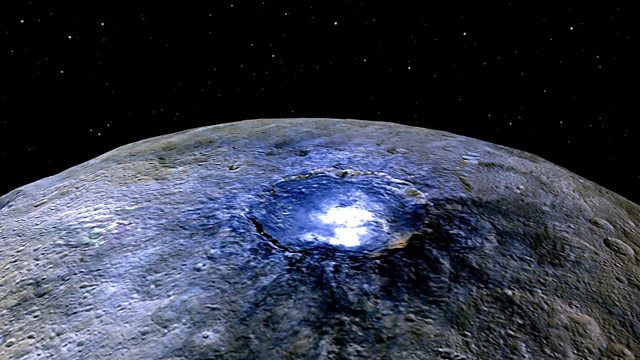
Bright Spots on Ceres
The surface of Ceres; Magnetoreception; The Quipu Project; Tackling Climate Change with Psychology; Humboldt; What is a Scientific Model?
Using data from the Dawn spacecraft, scientists make sense of the mysterious bright spots on surface of Ceres - the largest object in the main asteroid belt. Andreas Nathues of the Max Planck Institute for Solar System Research talks to 大象传媒鈥檚 Jonathan Amos about the bright spots on the surface of Ceres. They reveal a briny ice layer underneath the planetary body鈥檚 crust. In other research scientists find ammonia on the surface - which means Ceres must have formed in the outskirts of our Solar System - far far away from its current position. Jonathan explains the findings to Jack Stewart.
Magnetoreception
Is there a 6th sense? Since the 1960s, it has been generally accepted that animals have a sense of magnetism. This may help explain how some birds are able to migrate huge distances. However, ever since this discovery, the mechanism behind the reception of the Earth's magnetic field has remained a mystery. Scientists do not know which components are responsible for detecting the magnetism, hence the search for 'a biological compass'. The quest has united people from a range of disciplines such as animal behaviourists, chemists and quantum biologists. But are scientists getting any closer to finding the biological compass? Adam Rutherford discusses this question with Oxford University chemist Professor Peter Hore - and neurobiologist at the UK Institute for Molecular Pathology, David Keays.
The Quipu Project
An innovative interactive documentary provides a platform for people who underwent involuntary sterilization in a campaign devised by the then Peruvian President Fujimori in the 1990s. Gareth Mitchell talks to one of the key people behind the project, Rosemarie Lerner. The launch of the project coincides with International Human Rights Day.
Tackling Climate Change with Psychology
As the United Nations Climate Change Conference, or COP 21, comes to an end in Paris, Claudia Hammond talks to Dr Sander van der Linden, Director of the Social and Environmental Decision Making Lab at Princeton University, about how psychological science can help policy makers to communicate about climate change.
Humboldt - the Inventor of Nature
Alexander Von Humboldt - the forgotten father of environmentalism - warned of harmful human induced climate change over 200 years ago. Explorer, nature writer and scientist he climbed the world鈥檚 highest volcanoes and delved deep into the rainforests devising his radical new ideas of nature in flux. Darwin set sail on the Beagle because of Humboldt鈥檚 books. Roland Pease talks to author Andrea Wulf, who has retraced the footsteps of this remarkable lost hero of science.
What is a Scientific Model?
Adam Rutherford talks to astronomers Dr Andrew Pontzen and Dr Carole Haswell and ornithologist Dr Paul Donald about what they mean when they say they "modelled the data". He explores the strengths and weaknesses of using models to represent things as diverse as the spin of planets and field choice of skylarks.
The Science Hour was presented by Gareth Mitchell with comments from the 大象传媒 Radio Science Producer, Fiona Roberts
Editor: Deborah Cohen
(Image caption: This representation of Ceres' Occator Crater in false colours shows differences in the surface composition 漏 NASA/JPL-Caltech/UCLA/MPS/DLR/IDA)
Last on
More episodes
Previous
Next
Broadcasts
- Sat 12 Dec 2015 09:06GMT大象传媒 World Service Australasia
- Sat 12 Dec 2015 23:06GMT大象传媒 World Service except News Internet
- Sun 13 Dec 2015 02:06GMT大象传媒 World Service Australasia
- Sun 13 Dec 2015 11:06GMT大象传媒 World Service except Australasia & News Internet
- Sun 13 Dec 2015 14:06GMT大象传媒 World Service Australasia
- Mon 14 Dec 2015 06:06GMT大象传媒 World Service South Asia
Podcast
-
![]()
Unexpected Elements
The news you know, the science you don't

